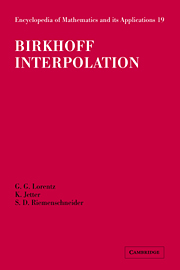Book contents
- Frontmatter
- Contents
- Editor's Statement
- Preface
- Introduction
- Chapter 1 Basic Definitions and Properties
- Chapter 2 Further Elementary Theorems
- Chapter 3 Coalescence of Rows
- Chapter 4 Applications of Coalescence
- Chapter 5 Rolle Extensions and Independent Sets of Knots
- Chapter 6 Singular Matrices
- Chapter 7 Zeros of Birkhoff Splines
- Chapter 8 Almost-Hermitian Matrices; Special Three-Row Matrices
- Chapter 9 Applications
- Chapter 10 Birkhoff Quadrature Formulas
- Chapter 11 Interpolation at the Roots of Unity
- Chapter 12 Turán's Problem of (0, 2) Interpolation
- Chapter 13 Birkhoff Interpolation by Splines
- Chapter 14 Regularity Theorems and Self-Dual Problems
- Bibliography and References
- Symbol Index
- Subject Index
Chapter 3 - Coalescence of Rows
Published online by Cambridge University Press: 05 April 2013
- Frontmatter
- Contents
- Editor's Statement
- Preface
- Introduction
- Chapter 1 Basic Definitions and Properties
- Chapter 2 Further Elementary Theorems
- Chapter 3 Coalescence of Rows
- Chapter 4 Applications of Coalescence
- Chapter 5 Rolle Extensions and Independent Sets of Knots
- Chapter 6 Singular Matrices
- Chapter 7 Zeros of Birkhoff Splines
- Chapter 8 Almost-Hermitian Matrices; Special Three-Row Matrices
- Chapter 9 Applications
- Chapter 10 Birkhoff Quadrature Formulas
- Chapter 11 Interpolation at the Roots of Unity
- Chapter 12 Turán's Problem of (0, 2) Interpolation
- Chapter 13 Birkhoff Interpolation by Splines
- Chapter 14 Regularity Theorems and Self-Dual Problems
- Bibliography and References
- Symbol Index
- Subject Index
Summary
INTRODUCTION
Coalescence of two rows of a matrix has been implicitly used by Ferguson [37, p. 14]. It has been formally defined by Karlin and Karon [70], who studied its influence on the regularity of the matrix and gave the Taylor expansion (3.5.2). Lorentz and Zeller [108] proved that the leading coefficient in this formula is different from 0. Lorentz [94] studied the coalescence of several rows. There are many applications of this method, for example, in [70, 91, 94, 103]. We discuss them in Chapter 4.
Let E = [ei, k] be an m × (n + 1) matrix, not necessarily normal, satisfying the Pólya condition (1.4.3). We interpret E as a vertical grid of boxes. If ei, k = 1, then a ball occupies the ith box in the kth column. We place a tray of n + 1 boxes under the column of the grid. Then the balls are permitted to fall from the grid into the boxes of the tray in such a way that if the box immediately below is occupied, the ball rolls to the first available box on the right. The condition (1.4.3) assures us that no ball will roll out of the tray. The distribution of balls in the tray constitutes the one-row matrix obtained by coalescence of the m rows of E. It is to be expected that the final arrangement of the balls in the tray is independent of the manner in which the balls were allowed to fall. Figure 3.1 is an example of coalescence of a two-row matrix.
Information
- Type
- Chapter
- Information
- Birkhoff Interpolation , pp. 26 - 37Publisher: Cambridge University PressPrint publication year: 1984
